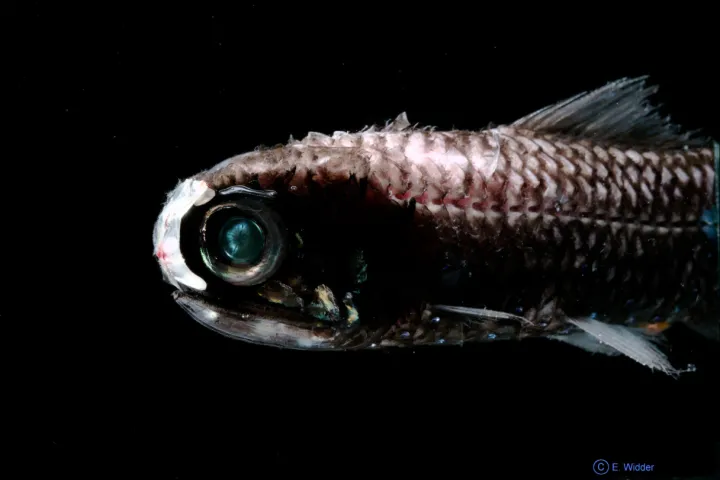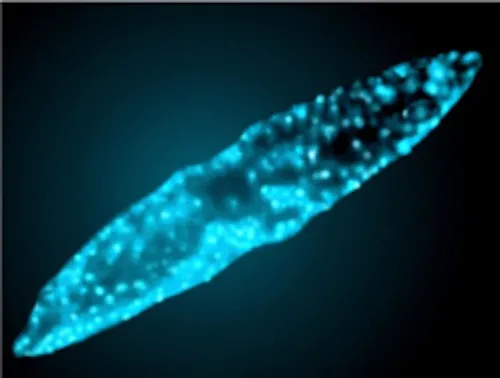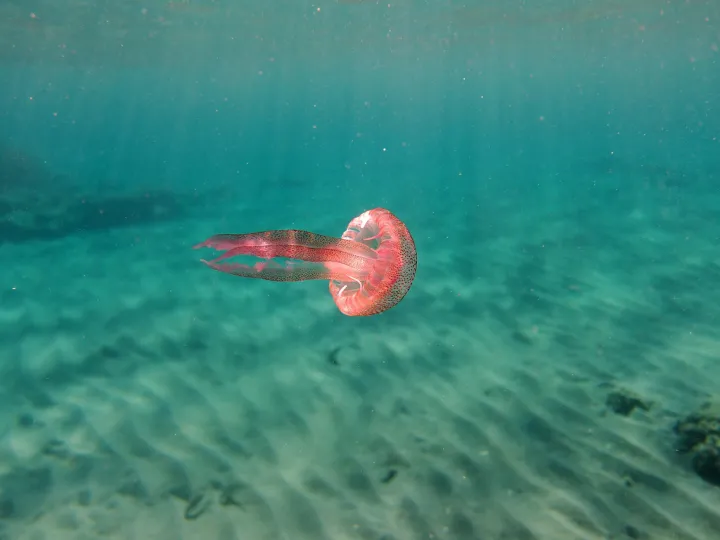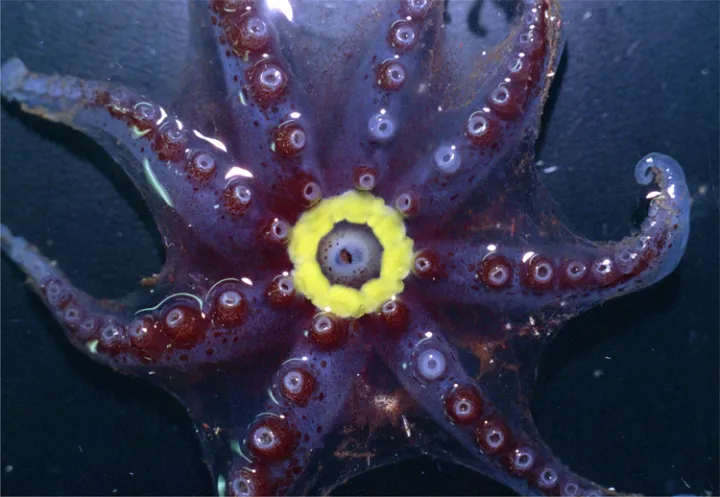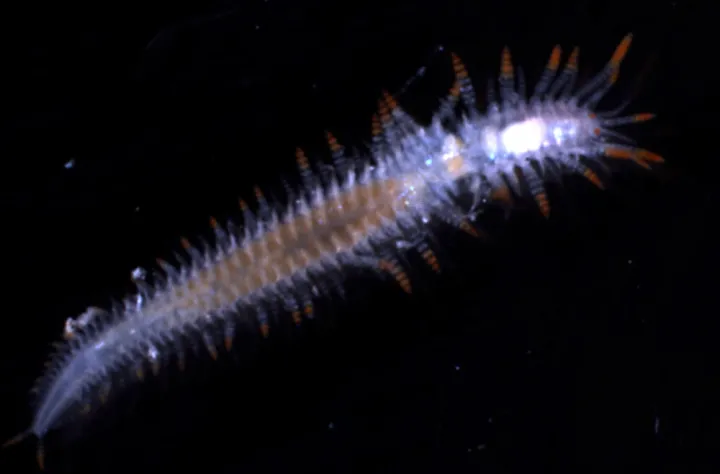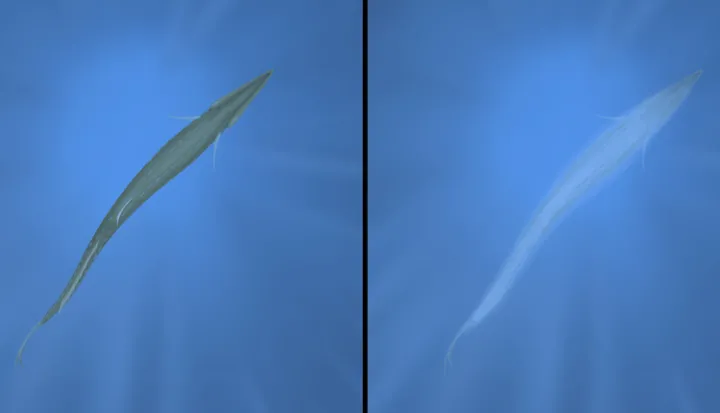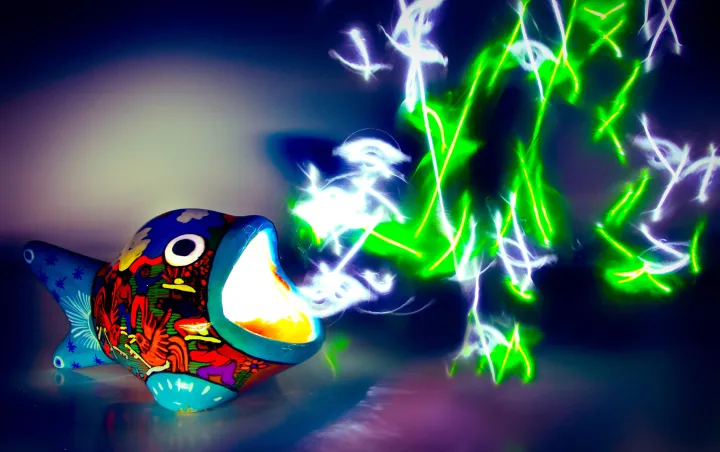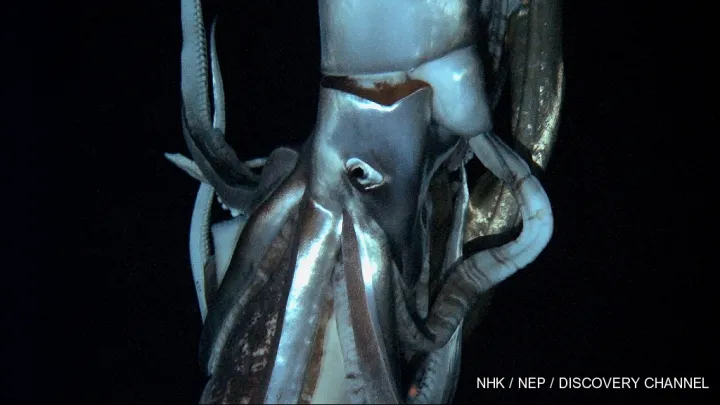
Bioluminescence
Introduction
You may have seen the sparkle of fireflies on a summer’s night. The fireflies produce light through a chemical reaction in their glowing abdomens, a process known as bioluminescence. But did you know that seascapes can also glow and glitter thanks to the light producing abilities of many marine organisms? Some fish dangle a lighted lure in front of their mouths to attract prey, while some squid shoot out bioluminescent liquid, instead of ink, to confuse their predators. Worms and tiny crustaceans also use bioluminescence to attract mates.
Humans primarily see bioluminescence triggered by a physical disturbance, such as waves or a moving boat hull, that gets the animal to show their light off, but often animals light up in response to an attack or in order to attract a mate. Bioluminescent organisms live throughout the water column, from the surface to the seafloor, from near the coast to the open ocean. In the deep sea, bioluminescence is extremely common, and because the deep sea is so vast, bioluminescence may be the most common form of communication on the planet!
Underwater Light
How it’s made
Bioluminescence occurs through a chemical reaction that produces light energy within an organism's body. For a reaction to occur, a species must contain luciferin, a molecule that, when it reacts with oxygen, produces light. There are different types of luciferin, which vary depending on the animal hosting the reaction. Many organisms also produce the catalyst luciferase, which helps to speed up the reaction.
Animals can closely control when they light up by regulating their chemistry and brain processes depending on their immediate needs, whether a meal or a mate. Some organisms even bundle the luciferin with oxygen in what is called a “photoprotein”—like a pre-packaged bioluminescence bomb—that is ready to light up the moment a certain ion (typically calcium) becomes present. They can even choose the intensity and color of the lights.
Who makes it?
Bioluminescence is found in many marine organisms: bacteria, algae, jellyfish, worms, crustaceans, sea stars, fish, and sharks to name just a few. In fish alone, there are about 1,500 known species that luminesce. In some cases, animals take in bacteria or other bioluminescent creatures to gain the ability to light up. For example, the Hawaiian bobtail squid has a special light organ that is colonized by bioluminescent bacteria within hours of its birth. But usually, the animal itself contains the chemicals necessary for the reaction that produces bioluminescence. The number of species that bioluminesce and the variations in the chemical reactions that produce light are evidence that bioluminescence has evolved many times over—at least 40 separate times! This number continues to grow as research makes new discoveries. In 2018, scientists discovered the ray-finned fishes themselves evolved bioluminescence 27 separate times. That's quite an increase from the handful of times that were known before.
Most deep-sea animals produce some bioluminescent light, but the phenomenon isn’t relegated to the deep: one of the most common sightings occurs at the surface of the ocean. Many small planktonic surface dwellers—such as single-celled dinoflagellates—are bioluminescent. When conditions are right, dinoflagellates bloom in dense layers at the surface of the water, causing the ocean to take on a reddish-brown color in daylight and a sparkly sheen as they move in the waves at night. When the dinoflagellates are poisonous to other animals, these events are called harmful algal blooms (HABs). When they're eaten, the toxic dinoflagellates accumulate in high concentrations in larger fish and filter feeding shellfish. And then when marine mammals or people eat these organisms, it can cause sickness or even death.
What Color is Bioluminescence?
Light travels in waves of different shapes—known as wavelengths—which determine the color of the light. When the waves hit our eyes, they are translated into colors by the brain depending on their wavelength. The wavelengths that our eyes can see are known as the "visible light spectrum," and we can see all the colors on this spectrum as they travel through the air above land. But light travels differently underwater because longer wavelengths can't travel as far. Most of the bioluminescence produced in the ocean is in the form of blue-green light. This is because these colors are shorter wavelengths of light, which can travel through (and thus be seen) in both shallow and deep water. Light traveling from the sun of longer wavelengths—such as red light—doesn't reach the deep sea. This is why many deep sea animals are red: it's effectively the same as being invisible. Moreover, because it's not present, many deep-water animals have lost the ability to see it altogether. However, some animals evolved to emit and see red light, including the dragonfish (Malacosteus). By creating their own red light in the deep sea, they are able to see red-colored prey, as well as communicate and even show prey to other dragonfish, while other unsuspecting animals cannot see their red lights as a warning to flee.
Why Animals Light Up
Feeding
Animals can use their light to lure prey towards their mouths, or even to light up the area nearby so that they can see their next meal a bit better. Sometimes the prey being lured can be small plankton, like those attracted to the bioluminescence around the beak of the Stauroteuthis octopus. But the light can also fool larger animals. Whales and squid are attracted to the glowing underside of the cookie-cutter shark, which grabs a bite out of the animals once they are close. The deep-sea anglerfish lures prey straight to its mouth with a dangling bioluminescent barbel, lit by glowing bacteria.
Attracting Mates
Animals don't only need to look for and attract food; bioluminescence can also play a part in attracting a mate. The male Caribbean ostracod, a tiny crustacean, uses bioluminescent signals on its upper lips to attract females. Syllid fireworms live on the seafloor, but with the onset of the full moon they move to the open water where the females of some species, like Odontosyllis enopla, use bioluminescence to attract males while moving around in circles. These glowing worms may have even helped to welcome Christopher Columbus to the New World. Anglerfish, flashlight fish and ponyfish all are thought to luminesce in order to tell the difference between males and females, or otherwise communicate in order to mate.
Protection
Often animals use a strong flash of bioluminescence to scare off an impending predator. The bright signal can startle and distract the predator and cause confusion about the whereabouts of its target. From small copepods to the larger vampire squid, this tactic can be very useful in the deep-sea. The "green bomber" worm (Swima bombiviridis) and four other similar worm species from the polychaete family release a bioluminescent "bomb" from their body when in harms way. These deep sea worms live close to the sea bottom and were only discovered in 2009. Some animals such as the deep-sea squid Octopoteuthis deletron even detach their bioluminescent arms, which stick to and probably distract their predators. All this commotion could also serve as a burglar alarm, attracting larger predators to the scene. In certain cases a predator might only get a bite of their prey, and the evidence will keep glowing from within its stomach.
Bioluminescence can also be used to help camouflage with the use of counterillumination. Photophores on the bottom side of an animal can match the dim light coming from the surface, making it harder for predators searching for prey from below to see what they are looking for.
Human Connections
Art
For the animals who bioluminesce, it is a matter of communicating and protecting themselves from being eaten or hurt. But for humans, the beautiful colors and light that are produced by bioluminescence can be works of art.
A temporary exhibit at the National Museum of Natural History in 2012 explored these links between art and science. Artist Shih Chieh Huang created hanging installations in the dark space of the museum that lit up and looked as if they were floating in the deep-sea. Some artists use the bacteria itself to create living drawings or entire exhibits with petri dishes full of the glowing single-celled organisms.
You can also make your own bioluminescent art!
Science
Bioluminescence can also be used as a tool by researchers to learn more about the ocean and its mysteries. Edie Widder, a scientist who specializes in bioluminescence, was with a group attempting to film the giant squid for the first time. She suspected that the giant squid would be lured to a bioluminescent light attached to a fake squid—not because it wanted to eat the small fake squid, but because its flashing light "burglar alarm" could mean that there was larger prey in the vicinity. Her theory proved right. A live giant squid was captured for the first time on film in 2012!


